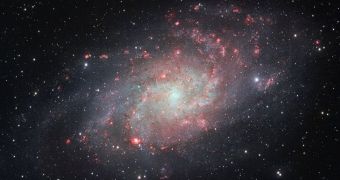This August 6, the European Southern Observatory introduced the world to an insanely detailed image of a spiral galaxy estimated to sit at a distance of about 3 million light-years from our planet.
The picture, available next to this article, was obtained with the help of the VLT Survey Telescope, the latest telescope to have until now been added to the Paranal Observatory in the Atacama Desert in northern Chile.
“This image was taken by the VLT Survey Telescope (VST), a state-of-the-art 2.6-metre survey telescope with a field of view that is twice as broad as the full Moon,” space researchers explain.
Furthermore, “This picture was created from many individual exposures, including some taken through a filter passing just the light from glowing hydrogen, which make the red gas clouds in the galaxies spiral arms especially prominent.”
In a press release available on its website, the European Space Observatory details that this galaxy usually goes by the name of Messier 33. However, there are some who like to refer to it as NGC 598.
Due to the fact that it is located in the constellation of Triangulum, Messier 33 is sometimes identified as the Triangulum Galaxy. Luckily, having this many names has not yet landed this spiral galaxy in trouble with the law.
In terms of size, Messier 33 is nothing short of impressive. Thus, this spiral galaxy is the third-largest member of the so-called Local Group of galaxies, which comprises our Milky Way, the Andromeda Galaxy, and roughly 50 other galaxies.
Interestingly enough, information at hand indicates that, probably because it has fallen in love with it and is dying to give it a hug, Messier 33 is currently traveling towards our Milky Way at a speed of approximately 100,000 kilometers per hour (62,137 miles per hour).
Still, given the distance between them, it will probably be a while until Messier 33 gets close enough to the Milky Way to plant one on it. The only good news is that, the closer this spiral galaxy gets to our own, the easier it is for astronomers to study it.
Scientists working with the European Space Observatory explain that, as noticeable in this image provided by the VLT Survey Telescope at the Paranal Observatory in Chile, Messier 33 comprises both clouds of gas and dust, and bright star clusters.
Of the Triangulum Galaxy's star forming regions, the one that astronomers are especially fond of is dubbed NGC 604. This is because this nebula measures about 1500 light-years across, and is several dozen times bigger than the Orion Nebula.

 14 DAY TRIAL //
14 DAY TRIAL //